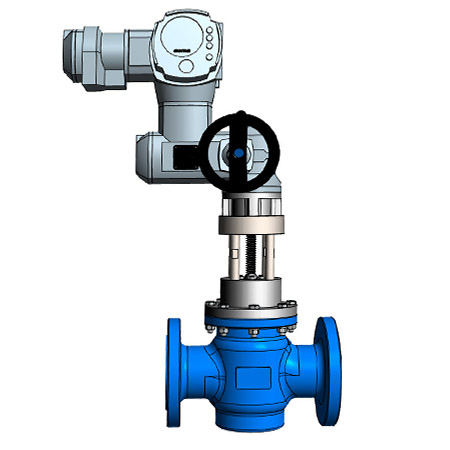How Control Valves Impact Power Efficiency in Industrial Settings
How Control Valves Impact Power Efficiency in Industrial Settings
Blog Article
Achieve Seamless Assimilation and Control With Quality Structure Automation Controls
In the realm of modern-day building management, the significance of top quality building automation controls can not be overemphasized. Embracing high quality structure automation controls is not simply a matter of benefit but a strategic crucial for organizations aiming to enhance their facilities' performance and sustainability.

Evolution of Building Automation Controls
Throughout the past couple of years, the advancement of building automation controls has actually substantially changed the means structures are taken care of and run. Initially, constructing automation systems mainly focused on standard features such as controlling ventilation, home heating, and air conditioning (HEATING AND COOLING) systems. Nonetheless, as modern technology advanced, these controls have come to be more sophisticated, permitting for a broader variety of structure systems to be integrated and handled centrally.
The development of developing automation controls has seen a shift towards more smart systems that can adjust to altering conditions in real-time. This flexibility is crucial for enhancing energy performance and guaranteeing occupant convenience. Additionally, modern-day structure automation controls currently supply functions such as anticipating maintenance, remote monitoring, and data analytics, allowing facility supervisors to make data-driven decisions to improve structure performance.

Benefits of Quality Assimilation
The development in structure automation manages in the direction of more intelligent systems has emphasized the significant advantages of quality assimilation in maximizing structure procedures and boosting overall effectiveness. This centralized control likewise provides much better presence and understandings right into structure efficiency, enabling proactive maintenance and optimization approaches. On the whole, the benefits of high quality assimilation in structure automation controls are undeniable, using boosted effectiveness, comfort, and functional performance.
Enhanced User Experience and Ease Of Access
Enhancing user communication with structure automation controls via intuitive style and enhanced ease of access raises the general experience for owners and facility supervisors alike. By concentrating on user experience, building automation systems can become a lot more easy to use and effective. Intuitive user interfaces, clear navigation, and customizable settings equip customers to connect with the controls conveniently and properly.
Ease of access attributes play a vital duty in ensuring that all people, consisting of those with disabilities, can make use of the building automation manages with ease. Incorporating features such as voice commands, responsive buttons, and color-contrasted screens can boost availability and make the controls extra comprehensive.
In addition, enhanced user experience causes greater user contentment, raised productivity, and far better decision-making. Occupants can readjust ecological setups according to their choices, while facility supervisors can effectively monitor and manage structure systems - control valves. In general, focusing on individual experience and accessibility in structure automation controls adds to an extra effective and seamless building atmosphere for all stakeholders entailed
Sustainable Practices Through Automation

Furthermore, automation can facilitate the combination of sustainable energy resources such as photovoltaic panels or wind turbines right into building operations. By automatically changing power use based upon the availability of renewable resource, buildings can even more minimize their dependence on non-renewable sources. This seamless combination of sustainable methods not just benefits the environment but also improves the general operational efficiency and cost-effectiveness of the structure. Through automation, buildings can line up with contemporary sustainability goals link and add to a greener future.
Future Trends in Building Control Solution
One famous trend forming the future of structure control systems is the boosted assimilation of Artificial Knowledge (AI) and maker knowing. Furthermore, the Web of Points (IoT) is transforming building control systems by connecting devices and sensing units to boost and enhance procedures efficiency.
Another essential fad is the emphasis on cybersecurity steps to safeguard versus possible dangers to building automation systems. As buildings end up being a lot more interconnected, guaranteeing robust cybersecurity protocols will certainly be necessary to guard sensitive data and avoid unauthorized access.
In addition, the shift in the direction of cloud-based systems is acquiring energy, permitting centralized control and remote accessibility to structure systems. This facilitates easier tracking, maintenance, image source and updates, improving the overall efficiency and flexibility of structure control systems. As innovation continues to development, these trends are expected to form the future landscape of building automation controls, driving innovation and sustainability in the constructed environment.
Verdict
Future patterns in structure control systems are likely to concentrate on more boosting automation capacities for improved energy efficiency and overall performance. It is essential for building proprietors and operators to prioritize the adoption of top quality building automation controls to maximize building procedures and attain long-lasting sustainability goals.
In the world of modern structure administration, the significance of quality building automation controls can not be overemphasized. On the whole, the advancement of structure automation controls proceeds to drive advancement in the building administration sector, using brand-new possibilities for producing smarter and much more sustainable buildings.
The advancement in building automation regulates towards even more smart systems has underscored the significant benefits of high quality assimilation in maximizing building procedures and boosting total efficiency. Generally, focusing on individual experience and accessibility in building automation controls adds to a more seamless and effective building go to these guys setting for all stakeholders involved.
It is vital for structure proprietors and drivers to focus on the fostering of high quality structure automation regulates to optimize building operations and achieve long-lasting sustainability goals. - control valves
Report this page